|
|
|
Sort Order |
|
|
|
Items / Page
|
|
|
|
|
|
|
| Srl | Item |
| 1 |
ID:
124482


|
|
|
|
|
| Publication |
2013.
|
| Summary/Abstract |
This article explores the political subjectivity of Kurdish children in urban Turkey. Often referred to as "stone-throwing children," since the early 2000s Kurdish children have entered Turkish public discourse as central political actors of the urban Kurdish movement. I suggest that the politicization of children can be understood in the context of transformations in age and kinship systems within the Kurdish community that were shaped by the forced migration of Kurds in the early 1990s. Focusing on the experiences of Kurdish children in the city of Adana, I argue that memories of violence transmitted by displaced parents, combined with the children's experiences of urban life, including exclusion, discrimination, poverty, and state violence, necessitate a reevaluation of how childhood is conceived and experienced within the Kurdish community. In a context where Kurdish adults often have trouble integrating into the urban context, their children frequently challenge conventional power relations within their families as well as within the Kurdish movement. In contrast to a dominant Turkish public discourse positing that these children are being abused by politicized adults, I contend that Kurdish children are active agents who subvert the agendas and norms of not only Turkish but also Kurdish politics. The article analyzes the ways Kurdish children are represented in the public discourse, how they narrate and make sense of their own politicization, and the relationship between the memory and the postmemory of violence in the context of their mobilization.
|
|
|
|
|
|
|
|
|
|
|
|
|
|
|
|
| 2 |
ID:
124488
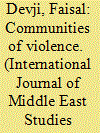

|
|
|
|
|
| Publication |
2013.
|
| Summary/Abstract |
Violence is a word seemingly meant for theorizing, being as abstract and thus as capacious as any category can be. And indeed the history of its use has only confirmed the all-encompassing character of violence, which can now name almost any kind of action or affect: physical, psychological, and even ideological. And yet this term is also deployed to name the most distinctive and visceral forms of cruelty and suffering, such that it is difficult to treat it merely as another abstract category. Shifting uncomfortably between the particularity of pain and the generality of an intellectual category, violence has until recently been ill served by scholarship. The necessities of justice, for example, have meant that violence is rarely the subject of law in its own right, but used only as a euphemism for some degree of murder or charge of battery. And since historians are especially seduced by legal terminology, perhaps because they have traditionally described and justified power, their efforts to mimic the law by finding some party responsible for something have tended not to deal productively with violence.
|
|
|
|
|
|
|
|
|
|
|
|
|
|
|
|
| 3 |
ID:
124478
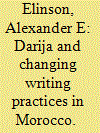

|
|
|
|
|
| Publication |
2013.
|
| Summary/Abstract |
Social, political, and technological changes have forced changes in the contemporary Moroccan linguistic landscape. In print media, advertising, music, fictional writing, and translation, Moroccan Arabic (d?rija) is being written in a variety of ways that point to a shift in perceptions and usage of d?rija in daily Moroccan life. In this article, I provide a discussion of recent developments in the use of d?rija in writing, and discuss how this evolving situation is articulated by intellectuals, journalists, publishers, fiction writers, and translators.
|
|
|
|
|
|
|
|
|
|
|
|
|
|
|
|
| 4 |
ID:
124475
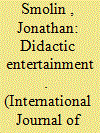

|
|
|
|
|
| Publication |
2013.
|
| Summary/Abstract |
This article traces the ways that the Moroccan Police Journal, a state-produced periodical that first appeared in 1961, constructed and disseminated an aspirational identity for the Moroccan police, one that was radically distinct from the image of the brutal security forces of the Protectorate period. Unlike other state-produced periodicals in Morocco or the Middle East at the time, Police Journal included fictional short stories written in the form of a police procedural, a genre that places a real-world criminal detective in the center of a narrative depicting a believable police investigation into a puzzling crime. As this article shows, these stories are the first examples of police procedurals in the Arabic language. The article examines three stories from Police Journal, tracing how they projected a new professional institutional culture for the police in the era of independence and served as both didactic pieces for police readers and entertaining works of fiction for the literate public.
|
|
|
|
|
|
|
|
|
|
|
|
|
|
|
|
| 5 |
ID:
124480
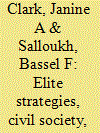

|
|
|
|
|
| Publication |
2013.
|
| Summary/Abstract |
This article explains the endurance of sectarian identities and modes of political mobilization in Lebanon after the civil war. This is done by examining three case studies that demonstrate a recursive relation between sectarian elites and civil society actors: on one side of this relation, sectarian elites pursue their political and socioeconomic interests at the expense of civil society organizations (CSOs); on the other side, civil society actors instrumentalize the sectarian political system and its resources to advance their own organizational or personal advantage. These mutually reinforcing dynamics enable sectarian elites to penetrate, besiege, or co-opt CSOs as well as to extend their clientelist networks to CSOs that should otherwise lead the effort to establish cross-sectarian ties and modes of political mobilization or that expressly seek to challenge the sectarian system. The article fills a gap in the literature on sectarianism in postwar Lebanon and helps explain a puzzle identified by Ashutosh Varshney in the theoretical debate on ethnic conflict, namely the reasons behind the "stickiness" of historically constructed ethnic identities
|
|
|
|
|
|
|
|
|
|
|
|
|
|
|
|
| 6 |
ID:
124481
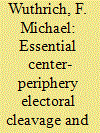

|
|
|
|
|
| Publication |
2013.
|
| Summary/Abstract |
For nearly forty years, scholars have utilized the metanarrative of a center-periphery cleavage first proposed by ?erif Mardin to explain a variety of phenomena in Turkish politics and society. When used to interpret electoral cleavages in the multiparty period, however, a center-periphery cleavage cannot effectively explain electoral outcomes. Focusing on the initial stage of multiparty competition, when the cleavage is often said to have been most salient, this article explores the empirical evidence to show that the concept as commonly employed has actually confounded an effective understanding of electoral behavior in Turkey. Rather than demonstrating a clear electoral division between the elites of the social center and the masses during this period, the article reveals two distinct cross-cutting patron-client strategies used by elite-dominated parties to cater to the rural population. The significant patterns of change in Turkey's electoral outcomes over time further illustrate the need to focus on how political parties and elites accumulate votes-that is, on their vote targeting strategies-rather than rely on static sociopolitical cleavages.
|
|
|
|
|
|
|
|
|
|
|
|
|
|
|
|
| 7 |
ID:
124471
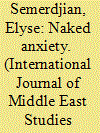

|
|
|
|
|
| Publication |
2013.
|
| Summary/Abstract |
In the 18th century, non-Muslims and women crossed social boundaries during a period of increased global consumption, prompting intervention on the part of Ottoman officials. On the imperial level, the sultan promulgated edicts to restrict such crossings, following the path of earlier laws that had regulated public spaces including bathhouses. In Aleppo, a local reflection of these 18th-century trends was increased monitoring of nudity and of contact between Muslims and non-Muslims within the city's bathhouses. Regulations required that bathkeepers provide separate bath sundries for Muslims and non-Muslims and prohibited co-confessional bathing for women in particular. With the assistance of guilds-and to a lesser extent millet representatives-complex bathing schedules for Muslim and non-Muslim women were registered at court to support segregation policies. Jurists discussing modesty requirements for Muslim women declared that non-Muslim (dhimm?) women were to be treated as unrelated men in that they were forbidden to gaze upon a naked Muslim woman. Shari?a court rulings were constructed along similar lines, indicating that the dhimm? woman was an unstable, liminal social category because in some circumstances her gaze was gendered male. Muslim male elites and local guilds ultimately instituted segregated bathing schedules to protect the purity of Muslim women from the danger posed by the dhimm? female figure.
|
|
|
|
|
|
|
|
|
|
|
|
|
|
|
|
| 8 |
ID:
124495


|
|
|
|
|
| Publication |
2013.
|
| Summary/Abstract |
Studies of violence relating to the Middle East have sometimes done more harm than they have explained. Like the intended effects of the U.S. military's doctrine of "rapid dominance," compared by its proponents to "tornadoes, hurricanes, earthquakes ... famine and disease," violence in the Middle East would appear to be "incomprehensible," though less to "the people at large" who are affected by it than to its prolific theoreticians.1 Over the past two decades, much of the literature on the region as a "cauldron of war"- generating five times its share (by population size) of total global conflict since the mid-20th century2-has tended to update and propagate well-known mythologies of primitivism, authoritarian personalities, and ancient hatreds.3 The significance of such mythopoeia has been its capacity to realize, at least in part, the conditions of its own truthfulness by shaping perception and policy, framing and enabling the infliction of a new wave of warfare on the region. Much contemporary writing on post-Cold War
global crisis, the geopolitics of instability, regional conflict, and the future of warfare4 has not only signally failed to understand the dynamics of the Middle East but has actively contributed to the spread of violence in the region.
|
|
|
|
|
|
|
|
|
|
|
|
|
|
|
|
| 9 |
ID:
124474
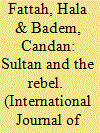

|
|
|
|
|
| Publication |
2013.
|
| Summary/Abstract |
From 1891 to 1911, a disenfranchised shaykh of the Muntafiq tribe, Sa?dun al-Mansur, led a large uprising against Ottoman rule in southern Iraq. Feeling that he had been disinherited from properties that were his birthright, he fought battle after battle against rival family claimants, shaykhs in Arabia and the Gulf, and reformist Ottoman governors in Baghdad and Basra. This article analyzes Sa?dun's insurgency both within the context of his life and against the background of shifting socioeconomic and political events in Iraq, Arabia, and the Gulf at the turn of the 20th century. One of the last rebellions against Ottoman central authority in southern Iraq, the insurgency was also notable for the indirect but intriguing links between the rebel shaykh and his nominal overlord Sultan ?Abd al-Hamid II, who paid special attention to the rebel's fate.
|
|
|
|
|
|
|
|
|
|
|
|
|
|
|
|
| 10 |
ID:
124491
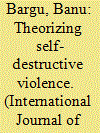

|
|
|
|
|
| Publication |
2013.
|
| Summary/Abstract |
The first image that the question of violence in the Middle East conjures up, especially in the West, is that of the suicide bomber. This association, etched into the political imaginary particularly over the course of the last two decades, is due neither to the number of victims suicide bombing creates (more conventional weapons of war can claim as many or more victims), nor to the identity of its victims (conventional weapons are also often directed at civilians). Rather, the potency of the image of the suicide bomber is connected to the simultaneously self-destructive and other-directed form that this act of violence takes. If the Orientalist impulse that has raised the image of the suicide bomber to iconic status is deeply problematic, it nonetheless constitutes an involuted acknowledgement of a reality: the significant rise in self-destructive violence (and not just in the Middle East). I have in mind practices such as hunger striking, self-immolation, and fatal self-mutilation, which constitute an emergent repertoire of struggle that has come to mark a certain current of radical politics around the globe. Those modalities of self-destructive violence that are not directed at others are overshadowed by suicide bombing.
|
|
|
|
|
|
|
|
|
|
|
|
|
|
|
|
| 11 |
ID:
124483
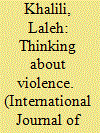

|
|
|
|
|
| Publication |
2013.
|
| Summary/Abstract |
Colleagues with whom I spoke about this piece had one of two responses: "Why do you want to feed the flames of cliché and prejudice about violence in the Middle East?" and "Surely, there has been no theorization of violence in the Middle East." Regarding the first response, I agree that thinking about violence in the Middle East can be a fraught enterprise. This is because a hysterical mainstream narrative locates the sources of violence in or emanating from the region in Islam(ism) or attributes it to some half-baked but remarkably persistent cultural explanations (tribalism, ancient hatreds, cycles of violence, etc.) which uncomfortably echo the racism of an earlier scholarly era. But enough innovative works have emerged on violence that we can move-at least in our scholarly conversations-beyond this terrain of prejudice and paranoia.
|
|
|
|
|
|
|
|
|
|
|
|
|
|
|
|
| 12 |
ID:
124486


|
|
|
|
|
| Publication |
2013.
|
| Summary/Abstract |
An important issue in considering violence at both the conceptual and empirical levels is the question of what counts as "violence" and how it is acknowledged. In many polities of the Middle East, including Palestine, Iraq, and Afghanistan, there is no clear boundary between war and peace. Conflicts have lasted over a long period and even the project of securing a future in which the struggle for decolonization and political autonomy can be kept alive faces enormous hurdles as everyday life is corroded by betrayals, accusations, and the sheer exhaustion of keeping political energies from waning. Most acute observers of prolonged conflicts recognize the corrosive effects of these conflicts on everyday life. In this brief thought piece, I want to reflect on one aspect of the problem: that of the relation between sexual violence as an aspect of dramatic and spectacular violence-in wars (including modern ones), pogroms against ethnic or religious minorities, or episodes of lethal riots between sectarian groups-and everyday forms of sexual violence that could be both part of the public domain and constitutive of domestic intimacy. Said otherwise, I am interested in how experience of violence travels from one threshold of life to another.
|
|
|
|
|
|
|
|
|
|
|
|
|
|
|
|
| 13 |
ID:
124494
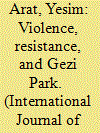

|
|
|
|
|
| Publication |
2013.
|
| Summary/Abstract |
As a student of politics whose primary research interest is in women's political participation in Turkey, my engagement with the study of violence is through the lens of gender.1 In gender studies, "violence" is arguably the most important critical concept for the articulation of the personal as the political. Women's recognition that violence in their personal lives and intimate relationships needed to be problematized in the political realm and transformed through public debate was a revolutionary development. Bringing this recognition into the canon of political thought has been a major contribution of feminist theorists.
|
|
|
|
|
|
|
|
|
|
|
|
|
|
|
|
| 14 |
ID:
124484


|
|
|
|
|
| Publication |
2013.
|
| Summary/Abstract |
Historical sociology has long been concerned with the study of organized state violence. Since the mid-1970s, a substantial body of work has come to focus on the importance of warfare to historical processes of state formation. The first generation of this literature proposed that the relentless existential struggle between the warring polities of medieval Europe had favored the survival of states that could adopt ever more efficient means to extract and mobilize resources from the local population to feed the war effort. Early states therefore evolved the institutions to collect taxes and administer territory largely as a functional byproduct of interstate military competition. From this perspective, the logic of war making was the driving force behind the rise of the modern state in Europe.
|
|
|
|
|
|
|
|
|
|
|
|
|
|
|
|
|
|
|
|
|